YuYu interview Allan P Judd
 |
| (*Note this Interview took place while flying high above San Diego aboard the Sanyo Lightship) Good morning and welcome aboard the Sanyo Lightship. —— Thanks for having us. Where will we be going today? Our flight will be approximately 1 hour long, from Brown Field and back. Right now we are flying at about one thousand feet above the ground, traveling down the 905, and we’ll cross over to Imperial Beach in just a moment. The control tower will then release us from this frequency. From Imperial Beach we’ll be able to see some seals, dolphins, and birds all playing in the water. We’ll see some surfers along the way, we’ll then go along the Coronado keys, then come back across the salt flats out here where they manufacture sea salt, and then back to Brown Field. 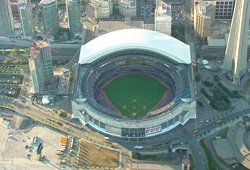
High above the Toronto Skydome for a baseball game and capturing Chicago’s cityscape.
Okay, I’ll give you a little airship 101 class. You can see the airship is kind of bobbing around, very much like being on a boat out in the ocean. I want you to think of this airship as a birthday balloon — a very large one. These airships, unlike others, have no rigid internal structures and so they start out flat as a pancake, before they’re inflated with helium. As they inflate, the helium pushes aside the heavier air, which is being drawn to the earth. Since the helium in this bubble is lighter than air, it wants to float up — just like an air bubble in water! When we inflated this airship it pushed aside 8000 pounds of air, so it has an upward buoyancy force provided by the air around it of 8,000 pounds, or about four tons. In effect, this is an antigravity machine—that’s why we are floating in the atmosphere. —— So, how long does it actually take to inflate one of these? 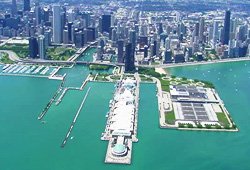 Well, it’s done in a hanger and, on average, it takes 10 days to complete. See these brown cylinders? They’re filled with helium, and it takes approximately 500 of them to fully inflate the airship to it’s full size of 165’long, 55’high, and 46’wide. Well, it’s done in a hanger and, on average, it takes 10 days to complete. See these brown cylinders? They’re filled with helium, and it takes approximately 500 of them to fully inflate the airship to it’s full size of 165’long, 55’high, and 46’wide.—— What speed are we flying at now? I’ve got the power set pretty much for a cruise, a typical cross-country speed, of around 35 mph and we’ve got a maximum speed of right around 55 mph. If we were going to LA, that would be about a 6-hour flight. You have to remember, it’s not just the airship, the ground crew has got to get there too, in time to reassemble the mooring they’ve disassembled here. Their average speed, including fueling, feeding and assembly is also just around 35 mph. When we’re traveling I stay in touch with them on my second radio, but if I get so far ahead that I lose contact with them, then I wait a bit by doing some aerial display. Remember the story of the “Tortoise and the Hare”? We’re the tortoise and the ground crew is the hare. —— As we’ve been gaining altitude, I’ve noticed that we’re bobbing around a little more, what causes that? This machine is completely different than anything else—it’s not heavier than air—it’s lighter than air, so it’s very susceptible to the wind. What’s happened now is that the sun has popped out and it’s warming the ground, which in turn warms the air that’s in contact with it. That warm air then becomes lighter than the air around it and cool air comes in and displaces it—in effect there is a “bubble” of warm air going up into the atmosphere. The sun actually “boils” the atmosphere to where at 3 o’clock in the afternoon we won’t carry passengers. We usually reserve mornings and late afternoons for passenger flights. Right now we are headed to the ocean and when we get there it’s going to be very smooth, because while ground warms the air—the ocean doesn’t. It’s like turning off the heat on the kitchen stove. —— So we’re floating around like a cork in the water? Actually, we are nothing more than a fish in an aquarium. If you’ve watched a fish swim around… they can swim up or swim down and they don’t slow down or speed up. They just go wherever they want to go at a constant speed. Same thing with the airship, our speed remains relatively constant. So right now we’re at the bottom of the “ocean” of air and we’re simple floating and bobbing around in the air bubbles. When we reach the water it’ll be things will settle down and it’ll be smooth sailing. —— Are there any limitations on how high or low we can go? Over the city we have to be 1,000 feet above the buildings…and once we’re over a rural environment or the ocean, I can go right down and put the ropes in the water if I wanted to. Just so long as I stay 500 feet away from people or objects. We can fly as high as 10,000 feet to cross mountain ranges, but today we won’t climb higher than our pressure height of 3,500’. What I’m going to do now is I’m going to turn slightly to the left around the pier and you’ll see, down in the ocean, some dolphins and so on playing in the water. —— I’ve heard these aircraft called blimps, zeppelins, airships…why is this one called a lightship? It’s not because we are lighter than air—it’s because at night we’re illuminated! Inside the envelope we have two1,000-watt lights that light up the airship. The Sanyo logo can be seen up to 4 miles away during the day and at night, when the lights are on, we can be seen from about 2 miles away. Sometimes people even think we’re a UFO! When people see us, a lot of folks don’t realize there are people in here…we can hold up to nine passengers. 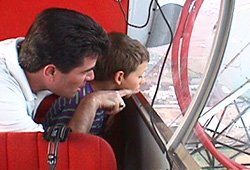
Sanyo and the Lightship Group work with “Believe in Tomorrow” making kids dreams come true in every city they visit.
Primarily we are an advertising platform. This particular ship travels all over the country as a goodwill ambassador for Sanyo, from coast to coast, north and south, east and west. By the end of the year we will have moored at 66 different locations, as far east as Toronto, and as far north as Vancouver. Sanyo leases the airship and The Lightship Group owns and operates this and other airships. Partnering with companies like Sanyo allows us to exist financially, because just performing public services for the likes of the Forestry Service, Police, Dept. of Transportation etc., doesn’t provide enough income, so we partner with an advertiser like Sanyo. You saw our crew ...and that was only 10 out of the16 people. Wherever we go, they have to come along for support, so all of that adds up. It’s nice because Sanyo’s offices are just up the street from Brown Field where we moor the airship. Today, once we finish with our passenger responsibilities, Adrian (the airship’s other pilot) and I will spend the rest of the day doing aerial display. People just love to see the airship, but some of them are actually surprised to see people in it. My grandmother always said, “Son, don’t fly low and slow!” but here we are 150 feet off the beach. Now that we’ve been to the bottom, we’re going to fly to our pressure height of 3,500 feet by completely deflating our ballonet, allowing us to climb. 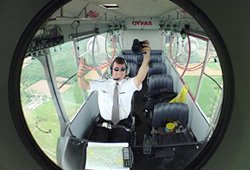
Alan capturing a self-portrait in the Lightship’s gondola.
What’s happening is at sea level the weight of the entire atmosphere is sitting on you. It’s also sitting on all the air around us and compressing it as much as naturally possible. As we rise in the atmosphere we are above more of it, and there is less weight on it and it expands. The air that is trapped inside your eardrum also expands, stretching your eardrum and eventually it will open and vent into your Eustachian tube, releasing air into your throat. —— So since you do this every day, do your ears acclimate? Yes, now my passage way automatically opens and closes with the smallest movement. When we descend, you’ll feel it again, the air in your ears will contract and they’ll need to be re-inflated. Notice how now that we’ve climbed above the marine layer how clear and beautiful the air is? —— It really is amazing, like a different world. Allan, how did you get interested in flying? Well, every kid wants to be Peter Pan right? That and my dad was a pilot — 41 years with TWA. In fact, he was the first person after Charles Lindberg, to fly solo across the Atlantic in a single engine airplane without an autopilot. So, I suppose some of his adventurous spirit rubbed off on me. I started flying when I was 16 and used to ride my bike the airport for lessons. At 17, I got my pilots license in New Jersey, and a year later I got my driver’s license. That was kinda neat. I stayed a private pilot for a while, went to oceanography school in Florida, and then went to work at sea doing some offshore seismic work. I did that for 3 or 4 years and then I ended up in Australia. That’s when I became flight instructor and then a commercial pilot…about 21 years ago. —— What got you interested in airships? After teaching people to fly airplanes for three or four years, an airship came to Bankstown to cover the America’s Cup yacht race in Perth, Australia. As chance would have it, for my birthday, I was given a ride on it! That’s when it happened…standing on the ladder of the airship…everything thing just clicked for me. I realized what I wanted to do and I saw how everything just came together…my oceanography training, flying background…everything just fit with this flying machine. So now I get to be Peter Pan everyday. 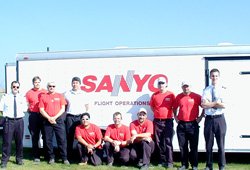
Crew members in front of their mobile command center at San Diego’s Brown Field.
This is a buoyancy vessel, it has nothing to do with a heavier than air craft. If we cut the engines we’ll float—everything else drops. Helicopters can do some of what we do, but they are noisy and have so much more vibration. You can’t get a smooth image from a helicopter, if you need to keep your lens open for any period of time, like you can here. So airships are ideal for taking panoramic photographs, which require a very stable shooting platform. An airplane can’t travel this slowly. At this speed you’re actually able to study things—in an airplane everything becomes scenery; you don’t have time to focus on anything…like driving down the freeway. Everything just goes by too fast. That’s why airships are used for game counting, tracking the populations of different animals, where a helicopter would be too noisy and intrusive. Airships are also much more cost-effective than planes or helicopters—a 747 uses more fuel taxiing down the runway that we use in two weeks. —— Can you tell us about some of the special events that the Sanyo Lightship has covered? We’ve covered quite a few… the PGA, NFL and college football, MLB, and drag racin, for instance. The airship is a wonderful observation platform, so we’ve worked with various scientists, Whale Watch, even the Navy Seals. A couple years ago the Sanyo Lightship was one of five airships covering Super Bowl XXXIII in San Diego. That day, I knew that the Smithsonian Magazine was interested in having a picture of all five airships over the Super Bowl, but how do you put all five in the same picture? Well, you go above in a helicopter and have the airships fly in a formation so the camera can capture all of them. The problem was the cameraman, who was supposed to show up just after kick-off, didn’t show up until after halftime, and then shot us in a very different way. We still made the cover of the Smithsonian Magazine though. When we cover sports for the networks or cable, we carry a camera mounted outside the gondola and a cameraman. For golf events, we can follow a golf ball from 2,000 feet. On my instrument panel I have 12” color monitor, with a recorder and a remote and this little mirror here shows me which way the cameras pointing, so I can maneuver the airship to get the best possible shot. One of the things that I love about flying the Sanyo Lightship is doing drag races. We cover a lot of drag racing and the NHRA and ESPN 2 use our camera to provide coverage from the airship. It’s funny, those cars are doing 330 mph and doing a quarter mile in 4.5 seconds, but for our airship takes 43 seconds and we only get up to 43 mph. 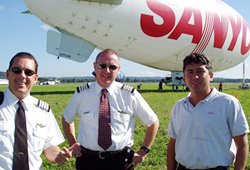
Alan in a rare moment on the ground, alongside former crew member Steve Tomlin and current Crew Chief, Cesar Mendez
to your work. Well, we have a very, very special cause that we participate in, in every city that we go to called “Believe in Tomorrow.” It’s a group that lends a hand to kids coping with life-threatening illnesses. In every city we coordinate with them and have a passenger list and a date just for the children and their families. That’s one of our highlights…we all just love to do that! I’ll never forget this little girl…she got out of the van and I thought I was looking at a little doll. She was 7 years old and so tiny, but when I brought her out to the airship—she stood up and walked into the airship. She was the most amazing child and just absolutely beautiful, with an incredible spirit. We’ve had other kids…I remember one boy who had just come out of the hospital and when he stood up here and I told him, “Son you are the commander” and he had me flying all over the place. Just having a ball. —— I’ll bet those kids light up brighter than the Lightship. Who wouldn’t? I’ll tell you who else lights up…the parents. Parents just love to see there kids enjoying themselves. They’ll hug each other and you can see the tears just pouring out as they’re watching their kids, who have endured so much, having so much fun. It’s a great feeling to be able to help in some small way. And the kids, they have chance, if just for a little while, to forget about whatever’s bothering them and be kids…and their parents get a chance to forget for a little while too. It’s wonderful job. —— And how about you Allan, how do you feel when you’re up here in the sky? This is great…it’s a very positive thing. This is where I live; this is playtime. When I get back on the ground I start working again. When I’m up here flying…its just wonderful. I love being at the interface between the land, the sea and the air. There are other places in the US where we fly that are just as beautiful, but right here at this meeting point is special. Right here in the sky, over the water—this is as good as it gets. (02-01-2005 issue, Interviewed by Terry Nicholas) |

